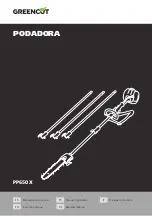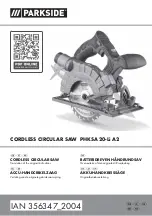
Safety Instructions for Saws Fitted with Inner Blade Guard
a) Make sure that the lower blade guard is properly closed before each use. Do not
use the saw if the lower blade guard does not move freely and close immediately.
Never clamp or bind the lower blade guard in the open position. If the saw is
accidentally dropped the lower blade guard can be bent. Lift the lower blade guard
using the handle and make sure that it can move freely without touching the saw
blade or any other part of the saw in any of the saw’s cutting angles and depths.
b) Make sure that the spring on the lower blade guard works. If the guard or spring
does not work properly it must be repaired before the saw is used. The lower
guard can stick due to damaged parts, sticky deposits or a build-up of sawdust.
c) The lower blade guard may only be moved to the side for special operations such
as plunge sawing and compound sawing. Move the lower guard to the side using
the handle and as soon as the saw blade makes contact with the material the
lower guard must be released. For all other sawing the lower guard must work
automatically.
d) Always make sure that the lower blade guard is covering the blade before laying
the saw on a bench or the floor. An uncovered rotating saw blade can cause the
saw to move backwards and saw through everything in its path. Bear in mind that
it takes time for the saw blade to come to a stop after the power switch has been
released.
Additional Safety Instructions for all Saws Fitted with
Riving Knives
a) Use a riving knife compatible with the saw blade being used. In order for
the riving knife to work it must be thicker than the saw blade but thinner
than the kerf of the saw blade.
b) Adjust the riving knife according to the directions in this instruction manual.
Incorrect distance, incorrect position and alignment can lead to the riving knife
not preventing kickbacks.
c) Always use the riving knife except when plunge sawing. The riving knife must be
reattached if it is detached for plunge sawing. The riving knife could get in
the way when plunge sawing and cause kickback.
d) In order for the riving knife to work it must pass through the workpiece.
The riving knife cannot prevent kickback on short saw cuts.
e) Do not use the saw if the riving knife is bent. Even a small defect can slow
the closing time of a safety guard.
7
EN
G
LI
S
H
Summary of Contents for M1Y-140-900A
Page 2: ...2 ...








































